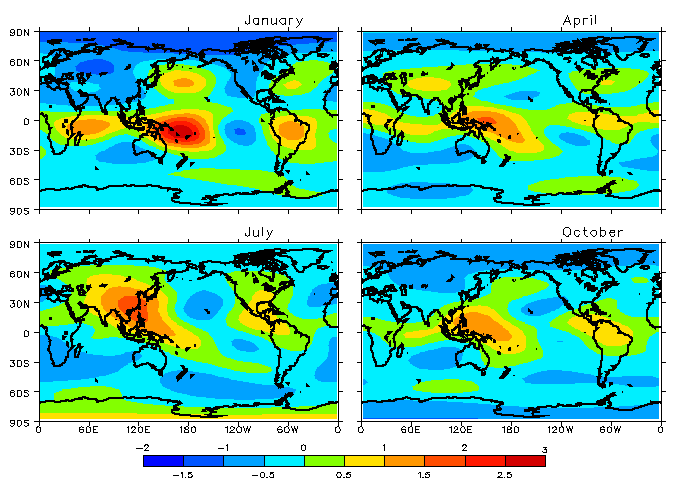

Vertically averaged heating rates (K/day) computed from the ECMWF Level III assimilated data for January, April, July and October 1979. Filtered to retain wavelengths greater than 10,000 km.
Horizontal distributions of vertically averaged heating for January, April, July and October 1979 computed from the European Centre for Medium-range Weather Forecasting (ECMWF) GWE assimilated data are shown above. These distributions were filtered to emphasize wavelengths greater than 10,000 km in order to: 1) focus attention on the planetary features of atmospheric heating that are basic to global monsoonal flows, 2) identify more clearly the impact of continents and oceans in forcing monsoons and, 3) contrast some key differences between summer and winter monsoonal circulations for land and ocean hemispheres.
The distributions reveal a systematic structure of differential heating associated with the meridional variation of incoming solar energy, the differing thermal response of oceans and continents, latent and sensible energy sources within baroclinic phenomena and tropical convection, and other factors. The most prominent global feature through the annual cycle is the region of heating that migrates with the sun over the equatorial western Pacific-southeast Asia sector associated with the seasonal evolution of the Asian monsoon circulation. Locally strong heating and monsoonal circulations over Africa and the Americas also migrate with the sun and changing seasons.
The influence of continents and oceans on the distributions of heating
is critically important to the forcing of monsoonal circulations. During
the Northern Hemisphere summer with the maximum incident solar radiation
over a land hemisphere, two primary regions of heating occur: one over
Asia and the other over the region of North America, Central America and
the northern one-third of South America. Large scale regions
of cooling occur over most of the Southern Hemisphere oceans and the
North Pacific and Atlantic Oceans. During the boreal winter when solar
radiation is maximized over an ocean hemisphere, five distinct regions
of heating constitute the major energy sources for the planetary scale.
Two occur over tropical/subtropical oceanic regions of the Southern Hemispere,
one over
South America and two over the Northern Hemisphere oceans. The dominant
region of cooling is a large, contiguous area in the NH that includes the
North American and Asian continents and the Arctic Ocean. Cooling also
occurs over the extratropical latitudes of the Indian Ocean. The above
distributions
clearly illustrate that the atmospheric heat sources and sinks
which drive the global monsoonal circulations are not uniformly distributed
but exhibit preferred locations and scales resulting from the seasonal
migration of incident solar radiation and the influence of continent-ocean
distributions and land versus ocean hemispheres. See Johnson (1989), Schaack et al. (1990) and Schaack et al. (1994) for a detailed discussion of the global
distributions of atmospheric heating.